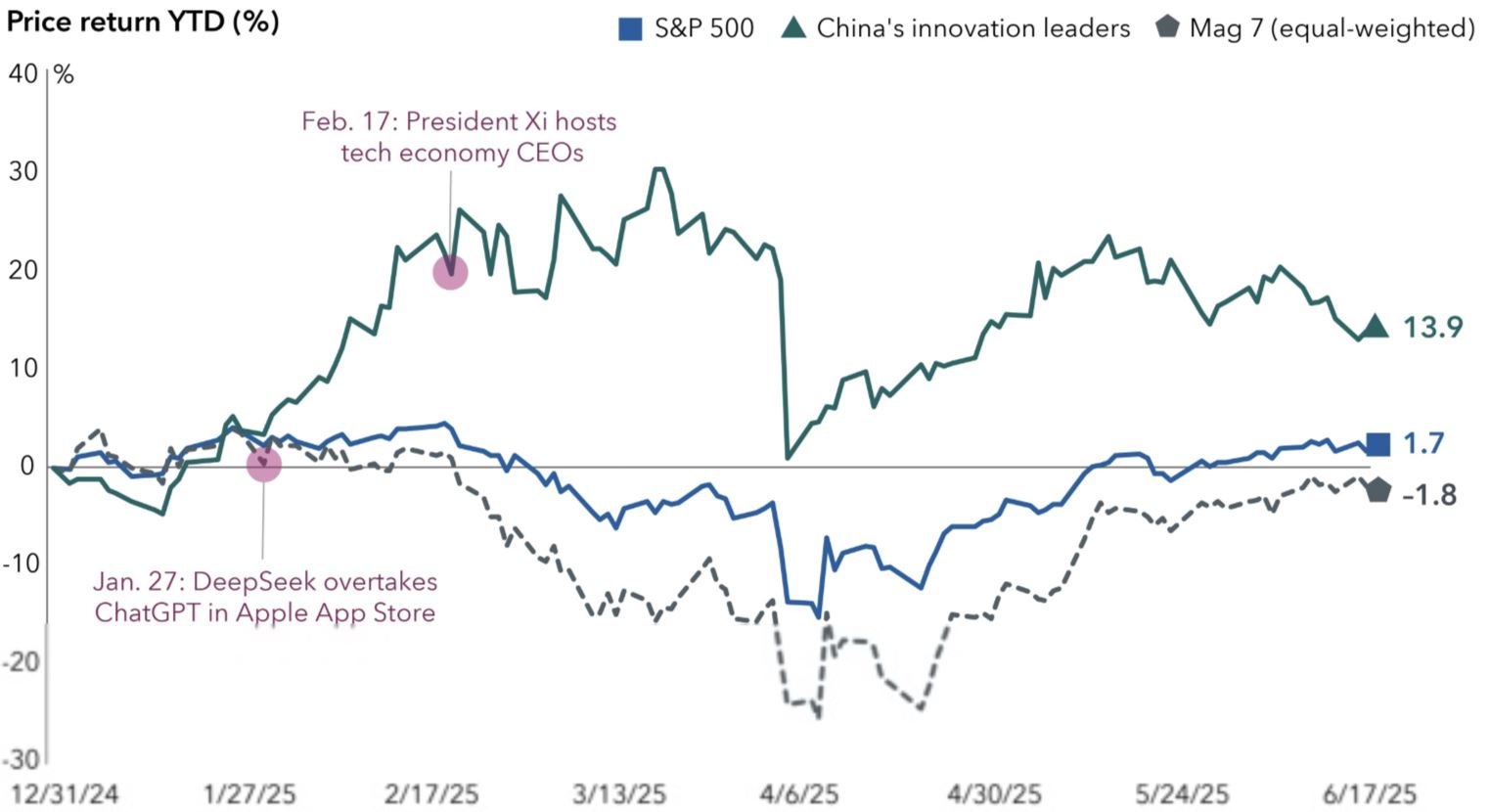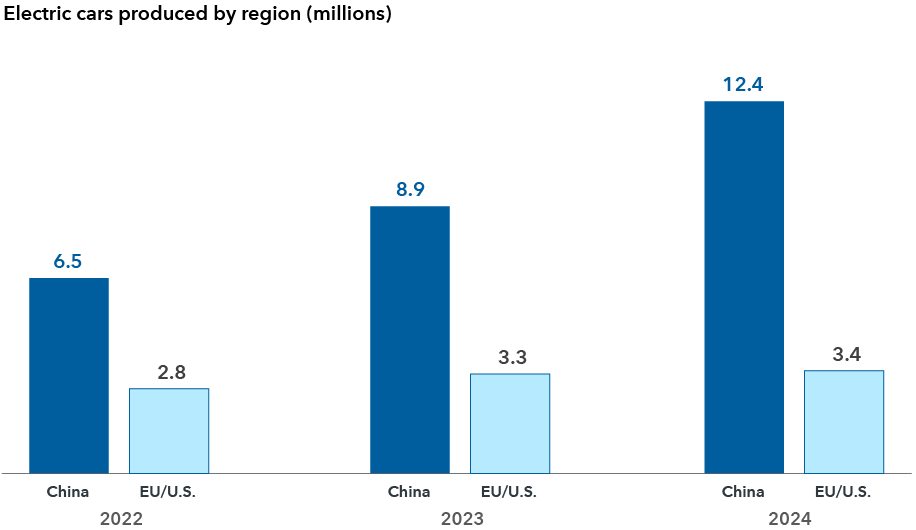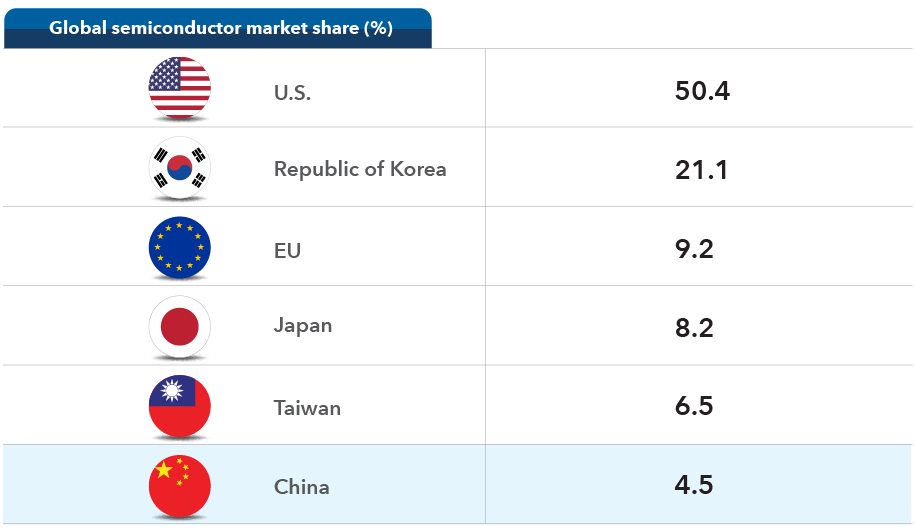Economic Indicators
China
In the early 2000s, a small cell phone battery manufacturer in China, known as BYD, made what the market believed was an unusual acquisition of a troubled domestic car manufacturer. BYD shares sold off on the news. Little did investors know that BYD’s leadership was laying the groundwork for what it saw as the company’s future.
Today, BYD is the world’s leading maker of electric vehicles (EV) and second-largest manufacturer of EV batteries, behind fellow Chinese company CATL.
China's dominance in this industry is a reminder of how the country has moved up the technology curve and can build massive scale when entrepreneurs are supported by favorable industrial policies. It’s not the first instance, and I believe it won’t be the last.
Having closely followed companies in China for 26 years, I’ve learned not to underestimate what businesses can achieve when it comes to making technological leaps. With AI marking the next competitive frontier, especially between the U.S. and China, here are a few of my observations on innovation in China.
1. DeepSeek marked pivotal moment in global AI race
Out of nowhere in January, little-known Chinese startup DeepSeek stunned global markets with the release of its open source artificial intelligence (AI) training model, shifting the narrative from the U.S. as the leader in the AI race. Within days, DeepSeek overtook ChatGPT in downloads in Apple’s app store. It marked a pivotal moment.
DeepSeek demonstrated that China can innovate even under tight constraints — without relying on state-of-the-art semiconductors. I would argue its AI model, while not surpassing U.S. competitors, holds its own. Importantly, it’s become a beacon of national pride. In February, President Xi Jinping and top party leaders seized the moment to host a rare meeting in Beijing with the country’s most prominent entrepreneurs. The underlying message: It’s time for the tech sector to make its mark.
Since DeepSeek’s emergence, there is a renewed sense of confidence among government officials and companies, giving hope to what China can accomplish to differentiate itself as an industrial complex. Many are now more willing to embrace AI and explore its use cases.
China’s tech leaders gain on Mag 7

Source: FactSet. P/E: price-to-earnings. Mag 7: Alphabet, Amazon, Apple, Meta, Microsoft, Nvidia and Tesla. China’s innovation leaders: Alibaba, BYD, JD.com, Meituan, NetEase, PDD Holdings and Trip.com. Data from December 31, 2024, to June 17, 2025.
This is important because over the past 15 years, China leapfrogged in many ways.
A prominent example would be mobile internet services, as smartphones, not personal computers, were the first computing device for millions of people. Companies like Tencent and Alibaba built the world’s leading super apps — digital platforms that offer a range of everyday services, such as financial payments and e-commerce, within a single application.
Some of my investment colleagues and I have noticed the accelerated digitization of China since the country reopened after COVID. The use of cash has become an anomaly, making it hard to buy food, pay for a cab or conduct other daily transactions without apps like Tencent’s WeChat.
E-commerce and social media are other areas where companies have driven global innovation, ranging from group buying to live streaming and short videos to sell products and offer experiences not seen on other platforms or in traditional retail stores. TikTok, for instance, is a worldwide phenomenon.
2. Chinese companies excel at improving existing technologies
That brings me to my next point. China excels at taking existing technologies and improving them at a rapid pace and low cost, both at the manufacturing and application level. I call this going from one to 10, rather than inventing a new product from scratch.
China’s growing dominance in the global EV market exemplifies this. For example, Xiaomi, the world’s third-largest smartphone maker, built both an impressive EV from scratch (where Apple fell short) and set up a highly automated EV manufacturing plant, all within three years.
China has accelerated electric car production

Sources: Capital Group, based on data from International Energy Agency, Global Electric Vehicle Outlook 2025.
Elsewhere, growth has been astonishing in China’s biopharmaceuticals industry, which barely existed a decade ago. Large numbers of Chinese scientists who were educated or employed in the U.S. and Europe have returned to help create companies involved in drug development, testing and manufacturing. Momentum is building. This year alone AstraZeneca, Pfizer and Bristol-Myers Squibb announced multibillion dollar licensing deals with Chinese firms for potential cancer drug treatments.
Humanoid robots are another targeted growth area. Many industrial companies are exploring the possibilities, though development is still in the early stages.
EVs and biopharmaceuticals are examples of industries closely aligned with the government’s industrial policy that aim to enhance the competitiveness of China’s companies relative to the rest of the world. The initiative involves billions of dollars in government subsidies over a multiyear period. The practice has drawn the ire of some countries that lament such policies create an uneven playing field, unfair trade and excess capacity. The rise of China in solar is a past example.
3. China has the potential to overcome technology restrictions
The U.S. has curbed exports of high-end technology to China in hopes of slowing down the country’s technological development. Given the time, companies in China have shown a penchant for catching up. I have more confidence in the long term than the short term.
Restrictions have fueled the determination of the government and businesses to become more self-sufficient.
The country’s semiconductor industry illustrates this drive. Unlike mobile internet services or e-commerce, China has not produced a formidable competitor to companies in the U.S., Europe or other parts of Asia. While China is a producer of lower end chips used in consumer electronics, household products and communications equipment, its commercial semiconductor industry is relatively small and lags in producing advanced chips.
China could gain ground in chipmaking

Source: Semiconductor Industry Association. Data as of May 2025. Market share is the percentage of global chip sales by where a company is headquartered.
The industry fell behind, largely because Chinese companies depended heavily on international suppliers. Without production volume or design wins, scaling up and advancing technologically proved difficult. However, U.S. export controls are giving Chinese semiconductor companies a foot in the door with major Chinese customers.
Another factor I’m watching in semiconductors and other advanced areas of technology is the impact of tightening U.S. immigration policies. Chinese scientists and engineers have been returning home, potentially enhancing China’s innovation capabilities.
4. Innovation can come at a cost
China is an incredibly competitive market for developing new technologies, and investors must be mindful of high-growth areas in the economy. They are often flooded with too much capital and capacity, while facing grueling competition and intense margin pressure. Take the EV industry. Despite amazing strides in innovation, the industry is oversupplied with cars and has endured brutal price wars, both of which have limited profitability.
China’s specific industrial policies, both at the national and local levels, invite heightened competition since the government’s strategic planning is long term (10 years or more) and backed by substantial subsidies. National champions often emerge within certain sectors, but it takes time to determine what might be the better investment opportunities.
5. Fast-growing sectors have matured
That is one reason I’m focused on good capital allocators with dependable profit margins and that operate in fields with higher barriers to entry. My main focus is the broader internet and e-commerce space, which had an amazing period of growth from 2012 to 2020, with annual revenue climbing at rates north of 20%.
Growth rates have slowed due to market saturation. Some companies have demonstrated more discipline in terms of capital allocation strategies, while others have also initiated or increased dividends and share buybacks. This is an attractive development from an investment standpoint.
Don’t underestimate China’s future innovations
China’s technology industry has and will continue to rapidly evolve, marked by fierce domestic competition and an intense rivalry with the U.S. The combination of robust government support, a large domestic market to test ideas, the return of western-trained scientists and entrepreneurs, and a strong work ethic positions China as a formidable player in global innovation. As an investor, I’m watching closely for select opportunities.
The S&P 500 Index is a market-capitalization-weighted index based on the results of approximately 500 widely held common stocks.
The MSCI China Index captures large- and mid-cap representation across China A shares, H shares, B shares, Red chips, P chips and foreign listings (e.g. ADRs).
Don't miss our latest insights.
Our latest insights
-
-
-
Chart in Focus
-
Demographics & Culture
-
Manufacturing
RELATED INSIGHTS
-
Economic Indicators
-
-
Chart in Focus
Don’t miss out
Get the Capital Ideas newsletter in your inbox every other week
 Johnny Chan
Johnny Chan